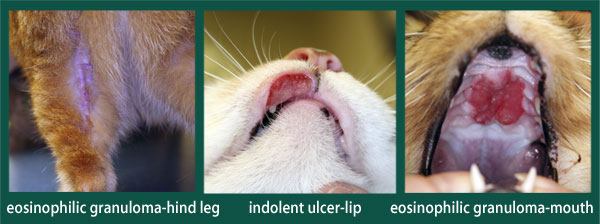What is EGC?
The term Eosinophilic Granuloma Complex (EGC) refers to a group of inflammatory skin and oral problems in cats:
- eosinophilic plaque
- eosinophilic granuloma
- indolent ulcers
What causes EGC in cats?
Most such lesions emerge when certain immune system cells (eosinophils) mistakenly release inflammatory chemicals to counter the invasion of parasites when, indeed, no such invasion has occurred. In any case, the chemicals will produce the clinical signs of allergy, such as itching, swelling, and inflammation.
Rather than parasitic invasion, some research studies suggest that the causes of these lesions are most frequently allergic reactions to flea, mosquito, or mite bites—or the bites of “anything else that injects saliva into an animal’s system.” Other possible causes include systemic reactions to substances including antibiotics, heart medications, allergy-inducing foods, and a wide variety of airborne pollens. Other studies suggest that the condition may at least be partially genetic or inheritable.

What are the clinical signs?
Three major forms in cats (all three forms may be observed in the same patient):
- Indolent ulcer
Well-demarcated ulcer (raised edges surround a pink-yellow ulcerated surface) on the upper lip (midline or adjacent to the maxillary canine tooth); may also affect the philtrum; nonpruritic, apparently painless.
- Eosinophilic granuloma
Nodules in oral cavity (dorsal and lateral tongue surfaces, hard and soft palate, glossopharyngeal folds) or at chin; surface often is speckled with small, dense white areas.
Erythematous, alopecic, raised, linear skin lesions on lateral thorax, lateral shoulder, or caudal aspect of thighs, variable pruritus and pain.
- Eosinophilic plaque
The third type is not common in the oral cavity, the symptoms are erythematous, raised plaque like skin lesions, commonly on the ventral abdomen, perianal region, and medial thighs, with variable pruritus and pain.
How is eosinophilic granuloma complex diagnosed?
The diagnosis is primarily visual and is confirmed by physical examination findings.
In order to obtain a definitive diagnosis, veterinarian may perform a fine needle aspiration (FNA). FNA involves taking a small needle with a syringe and suctioning a sample of cells directly from the lesion and placing them on a microscope slide. A veterinary pathologist then examines the slide under a microscope.
In some cases, results from FNA may not be entirely clear and a biopsy may be necessary. A biopsy is the surgical excision of a piece of the lesion. The appearance of the characteristic lip ulcers is highly suggestive and biopsy may not be required; however if lesions are located elsewhere on the skin or in the mouth, a biopsy will also rule out other diseases and conditions.
Treatment of EGC
If an underlying cause is identified, specific treatment will be directed at removing this cause.
Flea and insect control is very important in the treatment of feline eosinophilic complex. This is due to the suspected hypersensitivity reaction cause of the condition. Insect bites can trigger an exaggerated immune response in affected cats, causing or worsening clinical signs.
Some cats respond to elimination or hypoallergenic diets, suggesting an underlying food allergy as the cause. Most cats diagnosed with feline eosinophilic granuloma complex benefit from a hypoallergenic food trial.
Corticosteroids are the most common treatment to control the symptoms of eosinophilic granuloma complex. Corticosteroids are available in different forms that have different durations of activity; most often, cats are treated with corticosteroid injections or tablets. Treatment may last for weeks or months because eosinophilic granulomas frequently recur and prolonged treatment will minimize the chance of recurrence. Side effects of corticosteroids are usually not significant in cats, but prolonged use can cause side effects such as an increase in weight.
However, not all the cats can take steroids. If you have any question, it’s better to consult with your vet directly for the best possible treatment for your pet.
If you have any enquires, or need more advice, please contact us, or make an appointment for consultation
Source:
Feline Eosinophilic Granuloma Complex in Cats@VCA Hospital
Feline Health – Eosinophilic Granuloma Complex@Cornell University
